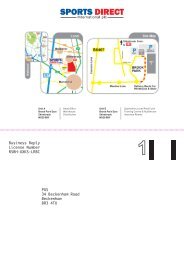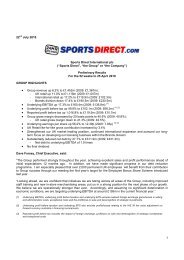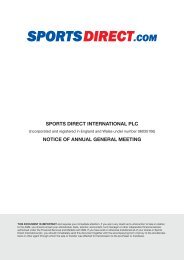Sports Direct Is The UK's Leading Sports Retailer - Sports Direct ...
Sports Direct Is The UK's Leading Sports Retailer - Sports Direct ...
Sports Direct Is The UK's Leading Sports Retailer - Sports Direct ...
You also want an ePaper? Increase the reach of your titles
YUMPU automatically turns print PDFs into web optimized ePapers that Google loves.
notes to the finanCial statements for the 52 weeks ended 26 april 2009 Continued<br />
2. CritiCal aCCountinG estimates and judGements<br />
<strong>The</strong> critical accounting estimates and judgements made by the Group regarding<br />
the future or other key sources of estimation, uncertainty and judgement that<br />
may have a significant risk of giving rise to a material adjustment to the carrying<br />
values of assets and liabilities within the next financial year are:<br />
impairment of goodwill<br />
<strong>The</strong> calculation for considering the impairment of the carrying amount of<br />
goodwill requires a comparison of the present value of the cash generating<br />
units to which the goodwill has been allocated, to the value of goodwill in the<br />
balance sheet. <strong>The</strong> calculation of present values requires an estimation of the<br />
future cash flows expected to arise from the cash generating units and the<br />
selection of a suitable discount rate. <strong>The</strong> key assumptions made in relation to<br />
the impairment review of goodwill are set out in Note 15.<br />
impairment of other intangible assets<br />
<strong>The</strong> calculation for considering the impairment of the carrying amount of other<br />
intangible assets with an indefinite life, specifically brands, trade marks and<br />
licences, requires a comparison of the present value of the cash generating<br />
units to the value of the other intangible assets in the balance sheet. <strong>The</strong><br />
calculation of present value requires an estimation of the future cash flows<br />
expected to arise from the other intangible assets and the selection of a suitable<br />
discount rate. <strong>The</strong> key assumptions made in relation to the impairment review<br />
of goodwill are set out in Note 15.<br />
useful economic life of intangible assets<br />
For intangible assets which have a finite life, the directors revisit their estimate<br />
of useful economic life at each period end and revise accordingly. Licences and<br />
trade marks typically have a life of between 10 and 12 years.<br />
identification and valuation of acquired intangible assets<br />
On acquisition, each material separable intangible asset is identified and valued<br />
by the directors with assistance from a professional third party. Any such<br />
calculation is judgmental in nature as it is based on a valuation methodology.<br />
Brand valuations are typically valued using the relief from royalty valuation<br />
methodology.<br />
<strong>The</strong> nature and carrying amounts of these assets are set out in Note 15.<br />
provision for obsolete, slow moving or defective inventories<br />
<strong>The</strong> directors have applied their knowledge and experience of the sports<br />
retail industry in determining the level and rates of provisioning required in<br />
calculating the appropriate inventory carrying values. <strong>The</strong> nature and carrying<br />
amounts are set out in Note 18.<br />
financial position of retirement benefit plans<br />
<strong>The</strong> net defined benefit pension plan assets or liabilities are recognised in the<br />
Group’s balance sheet. <strong>The</strong> determination of the financial position requires<br />
assumptions to be made regarding inter alia future salary increases, mortality,<br />
discount rates and inflation. <strong>The</strong> key assumptions made in relation to the<br />
pension plan are set out in Note 26.<br />
provision for dilapidations and onerous lease contracts<br />
<strong>The</strong> basis of the estimation of the provisioning for dilapidations and onerous<br />
lease contracts is detailed in the provision accounting policy and Note 28.<br />
Estimates and judgments are continually evaluated and are based on historical<br />
experience, external advice and other factors, including expectations of future<br />
events that are believed to be reasonable under the circumstances.<br />
3. finanCial risk manaGement<br />
<strong>The</strong> Group’s current activities result in the following financial risks and<br />
management’s responses to those risks in order to minimise any resulting<br />
adverse effects on the Group’s financial performance.<br />
foreign exchange risk<br />
<strong>The</strong> Group operates internationally and is exposed to foreign exchange risk<br />
arising from various currency exposures, primarily with respect to the US dollar<br />
and Euro. Foreign exchange risk arises from future commercial transactions,<br />
recognised assets and liabilities and net investment in foreign operations.<br />
Management has set up a policy to require group companies to manage their<br />
foreign exchange risk against their functional currency. To manage their foreign<br />
exchange risk arising from future commercial transactions and recognised<br />
assets and liabilities, entities in the Group use forward foreign exchange<br />
contracts, transacted with group treasury. Foreign exchange risk arises<br />
when future commercial transactions or recognised assets or liabilities are<br />
denominated in a currency that is not the entity’s functional currency.<br />
40<br />
Financial Statements<br />
interest rate risk<br />
<strong>The</strong> Group has net borrowings, which are principally at floating interest rates<br />
linked to bank base rates or LIBOR. <strong>The</strong> Group does not use interest rate<br />
financial instruments to hedge its exposure to interest rate movements. <strong>The</strong><br />
Group regularly monitors and reacts accordingly to any exposure to fluctuations<br />
in interest rates and the impact on its monetary assets and liabilities.<br />
Credit risk<br />
<strong>The</strong> directors have a credit policy in place and the exposure to credit risk<br />
is monitored on an ongoing basis. Credit evaluations are performed on all<br />
customers requiring credit over a certain amount. <strong>The</strong> Group does not require<br />
collateral in respect of financial assets.<br />
At each balance sheet date, there were no significant concentrations of credit<br />
risk. <strong>The</strong> maximum exposure to credit risk is represented by the carrying<br />
amount of each financial asset in the balance sheet.<br />
Investments of cash surpluses, borrowings and derivative instruments are made<br />
through banks and companies which must fulfil credit rating and investment<br />
criteria approved by the Board.<br />
liquidity risk<br />
<strong>The</strong> availability of adequate cash resources is managed by the Group through<br />
utilisation of its revolving bank and other facilities together with equity and<br />
retained profits thereby achieving continuity of funding and short-term flexibility.<br />
Capital management<br />
A description of the Group’s objectives, policies and processes for managing<br />
capital are included in the financial review on page 25 of this report.



![Our ref: [ ] - Sports Direct International](https://img.yumpu.com/19248141/1/184x260/our-ref-sports-direct-international.jpg?quality=85)






![Our ref: [ ] - Sports Direct International](https://img.yumpu.com/18440214/1/184x260/our-ref-sports-direct-international.jpg?quality=85)
